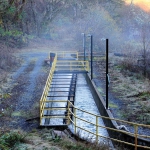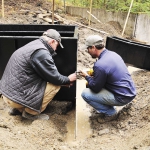A nonprofit organization that has been helping farmers install fish screens to improve fish passage while reducing irrigation costs now hopes to help growers generate their own hydropower.
The Farmers Screen was invented by staff of the Farmers Irrigation District and fruit growers in Hood River, Oregon, to address their problems with high sediment and debris loads carried by the glacially fed rivers and streams, which clogged diversion screens and damaged water intakes.
The irrigation district patented the technology and licensed it to the nonprofit Farmers Conservation Alliance, based in Hood River, with the proviso that sales revenue would be invested into other solutions that benefit both fish and farms. The FCA has been helping growers secure the funding and permitting necessary to install the screens.
The Farmers Screen is different from other fish screens in that it lies horizontally to the water surface, using the flow of the water to provide the cleaning action. Water moves over the screen surface at a relatively high velocity. The screen is a metal plate with holes that allow water to pass through only slowly so that fish and debris are not pulled against the surface but are moved over the screen and back into the river or stream. The screen has no moving parts and requires no electricity or maintenance.
The alliance has received approval from the National Marine Fisheries Service for use of the screen in streams that host endangered fish species, which means that individual farmers no longer need to have their projects reviewed by NMFS, a process that can take up to two years.
So far, FCA has installed 30 Farmers Screens, with seven more to be installed this fall. Genevieve Scholl-Erdmann, outreach manager, said the screens now serve more than 37,000 acres of farmland in Oregon, Washington, Idaho, Wyoming, and Montana, and are saving farmers a total of almost $500,000 a year in operation and maintenance costs compared with their previous equipment, generally rotary drum screens. And that doesn’t include benefits for farmers who previously had no screens at all.
Vertical screens can require a lot of labor to unclog. Scholl-Erdmann said one irrigation district had to provide a camper next to their old screen because the employee charged with cleaning it had to be ready to unclog it any time of day or night. A municipal water district built their employee a house at the site of their screen.
Fritz von Lubken, a former board member of the Farmers Irrigation District and a current board member of the FCA, said that before the Farmers Screen was invented, the irrigation district had a rotary screen.
“It was the biggest headache you could come across because it fouled and it broke down,” he said. “We were an open-ditch system, and there was no way we could ever become a pressurized, closed-ditch system because it just could not supply the water.”
The new flat screen does not clog, so the water keeps flowing, and it allows the fish to pass, providing environmental benefits, too.
Von Lubken grows a total of 160 acres of pears with his son Erick in two locations—one in the lower Hood River valley, which is served by the Farmers Irrigation District, and one in the upper valley, where the von Lubkens and neighbors installed a 1-cubic-foot-per-second screen. When they had their old rotary screen, Erick had to drive three miles up the creek each day to clean it.
“Now, he goes once every three to four weeks, just to make sure the screen’s still there,” von Lubken said. “That’s a huge savings. It’s more than paid itself back just because water’s always available and we do not have to attend to the screen. I would normally be very skeptical about this sort of thing, but now I’m a true believer. This is a win-win situation.”
The prefabricated, modular screens are manufactured in Portland, Oregon, and Missoula, Montana. The smallest screen, for a stream with a flow of around 0.5 cubic feet per second, costs about $18,500. A screen for a stream flow of 16 cubic feet per second would cost around $60,000. The cost includes a flume that brings the water to the screen. Custom-built screens can be designed for larger users that might prefer a concrete structure.
Hydropower
The alliance recently completed a capital campaign that raised $1.5 million to move beyond the demonstration phase and into the implementation phase. FCA hopes to install another 300 or so fish screens, opening more than 2,000 miles of river to safe fish passage.
Now, the FCA is looking at new projects, including the potential for in-conduit hydropower generation. It is collaborating with the Energy Trust of Oregon and the Bonneville Environmental Foundation, which are interested in developing low-impact, small-scale hydropower projects that could be incorporated into irrigation systems to provide an additional benefit. The idea is that an irrigation district or grower could install a turbine in an irrigation canal and generate electricity as the water makes it way to the farm.
Oregon has 20 hydropower systems installed within irrigation delivery systems, most of which were built in the 1980s when federal and state rules were more favorable than they are now. Recently, however, there’s been renewed interest in such projects at both the state and federal levels.
The FCA can evaluate a grower’s canal to see if there’s the opportunity to generate power, just as it does for the fish screens. Scholl-Erdmann said they’ve been working with irrigation districts to identify farms that have the potential.
Whereas the Farmers Screen can only be installed in locations with certain characteristics, including a drop in elevation and a minimum flow rate, turbines for hydropower can be installed in a wide range of situations. All that’s needed is moving water. However, they need to be able to tie into the electrical grid and the utility company must allow net metering.
The FCA has developed a questionnaire that growers can fill out to determine whether their site has potential to generate hydropower. If it does, FCA will try to help them make it a reality. The alliance can also give growers advice on improving the efficiency of their irrigation systems. •
Watch how it works
For more information go to: www.farmerscreen.org.









Leave A Comment